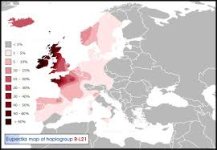Swammerdami
Squadron Leader
This week for show and tell I will outline part of the Y-chromosome clading tree in humans. It will take me several posts.
I am posting this in Social Sciences rather than Natural Science because the science and technology of DNA is of no interest in my topic. Let us instead interest ourselves in
In this thread we discuss the Y-chromosome only. It is SNP (single nucleotide) mutations which define the Y-tree, with a very few more major chromosome disruptions. (Decades ago, STR counts were much easier to test for; today the old STR database can be considered as hints about haplogroup.) Where DNA details become relevant we may be terse. (I may sometimes summarize technical considerations, perhaps inside Spoiler tags.) Those who carry an ancestor's Y-chromosome are called his agnatic descendants or simply agnates. (A woman is considered an agnate if her father is; her children won't be agnates unless she mates with an agnatic cousin.) mtDNA carriers are called uterine descendants. Estimate 30 and 25 years respectively for father-child and mother-child when estimating dates from number of generations.
In particular I want to present a quick overview of the Y-chromosome tree, following descent from Y-Chromosome Adam down to one particular King. I find some of these details intensely interesting, and I think some of you will too.
But before showing a slice of the Y-chromosome clading tree I want to discuss WHY it is an interesting type of DNA to look at. Three reasons are:
(1) Inheritance of Y-chromosome is simple. This means exact family trees can be inferred directly.
You have 275 billion g-g-g-g-g-g-g-g-g-g-g-g-g-g-g-g-g-g-g-g-g-g-g-g-g-g-g-g-g-g-g-g-g-g-g-g grandfathers (or rather 36-g grandfather SLOTS) who lived a thousand years ago but only ONE of those 275 billion is your agnatic ancestor: the man who gave you your Y-chromosome. Similarly the uterine (mtDNA) inheritance gives a long single line of grandmother-to-mother links.
On average there's about 1 SNP mutation per generation on the Y-chromosome. (Y-chromosome throughout actually refers to NRY -- nonrecombinant portion of Y -- to ignore the tiny runt end of Y which does do crossover with the tip of X.) mtDNA has 100 times the mutation rate per nucleotide, but Y-chromosome has 4000 times the number of nucleotides.
(2) The Y-chromosome map is "crisp" and therefore more informative than autosomal and mtDNA maps which are "blurred."
This is caused by patrilocality -- brides move to join their husband's setting. Tribes of Northeast Siberia tend toward matrilocality -- husbands join bride's family -- and indeed mtDNA maps have crisp tribe-related boundaries, while it is Y-haplogroup maps which are blurred. (Alleged rarity of matrilocality surprised me, as this is practiced in present-day rural Thailand! But indeed Google Search 'matrilocality' finds Thailand.)
(3) When caste or status is inherited from father, a Haplogroup can quickly dominate a population even if autosomal and mtDNA is largely unchanged from what it was prior to the new Y-Haplogroup.
I am posting this in Social Sciences rather than Natural Science because the science and technology of DNA is of no interest in my topic. Let us instead interest ourselves in
Conclusions about Prehistoric Migrations and Societies . . . that can be deduced from the detailed human family tree, specifically the Y-Haplogroup Tree.
In this thread we discuss the Y-chromosome only. It is SNP (single nucleotide) mutations which define the Y-tree, with a very few more major chromosome disruptions. (Decades ago, STR counts were much easier to test for; today the old STR database can be considered as hints about haplogroup.) Where DNA details become relevant we may be terse. (I may sometimes summarize technical considerations, perhaps inside Spoiler tags.) Those who carry an ancestor's Y-chromosome are called his agnatic descendants or simply agnates. (A woman is considered an agnate if her father is; her children won't be agnates unless she mates with an agnatic cousin.) mtDNA carriers are called uterine descendants. Estimate 30 and 25 years respectively for father-child and mother-child when estimating dates from number of generations.
In particular I want to present a quick overview of the Y-chromosome tree, following descent from Y-Chromosome Adam down to one particular King. I find some of these details intensely interesting, and I think some of you will too.
But before showing a slice of the Y-chromosome clading tree I want to discuss WHY it is an interesting type of DNA to look at. Three reasons are:
(1) Inheritance of Y-chromosome is simple. This means exact family trees can be inferred directly.
You have 275 billion g-g-g-g-g-g-g-g-g-g-g-g-g-g-g-g-g-g-g-g-g-g-g-g-g-g-g-g-g-g-g-g-g-g-g-g grandfathers (or rather 36-g grandfather SLOTS) who lived a thousand years ago but only ONE of those 275 billion is your agnatic ancestor: the man who gave you your Y-chromosome. Similarly the uterine (mtDNA) inheritance gives a long single line of grandmother-to-mother links.
On average there's about 1 SNP mutation per generation on the Y-chromosome. (Y-chromosome throughout actually refers to NRY -- nonrecombinant portion of Y -- to ignore the tiny runt end of Y which does do crossover with the tip of X.) mtDNA has 100 times the mutation rate per nucleotide, but Y-chromosome has 4000 times the number of nucleotides.
(2) The Y-chromosome map is "crisp" and therefore more informative than autosomal and mtDNA maps which are "blurred."
This is caused by patrilocality -- brides move to join their husband's setting. Tribes of Northeast Siberia tend toward matrilocality -- husbands join bride's family -- and indeed mtDNA maps have crisp tribe-related boundaries, while it is Y-haplogroup maps which are blurred. (Alleged rarity of matrilocality surprised me, as this is practiced in present-day rural Thailand! But indeed Google Search 'matrilocality' finds Thailand.)
(3) When caste or status is inherited from father, a Haplogroup can quickly dominate a population even if autosomal and mtDNA is largely unchanged from what it was prior to the new Y-Haplogroup.




